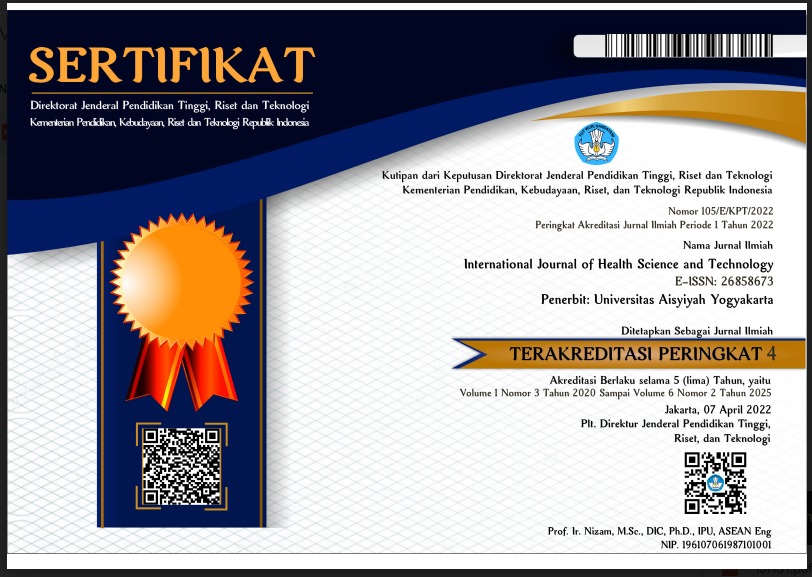Evaluation of electronic medical records implementation in outpatient services at the Hospital using MMUST Framework
DOI:
https://doi.org/10.31101/ijhst.v6i3.3897Abstract views 242 times
Keywords:
electronic medical records (EMR), hospital information system, health services, technology adoption, usabilityAbstract
Downloads
References
Abbad, M. M. M. (2021). Using the UTAUT model to understand students usage of e-learning systems in developing countries. Education and Information Technologies, 26(6), 7205–7224. https://doi.org/10.1007/s10639-021-10573-5
Afkarina, V. S. I., Wibowo, R., & Bukhori, S. (2021). Analisis kinerja SIMRS RSU Bhakti Husada Banyuwangi menggunakan IT Balanced Scorecard dan Model for Mandatory Use of Software Technologies. Multidisciplinary Journal, 4(1), 14–20.
Afkarina, V. S. I., Wibowo, R., & Bukhori, S. (2021). Success analysis of hospital management information system using MMUST and IT Balanced Scorecard (Case study of Bhakti Husada General Hospital Banyuwangi). Health Notions, 5(12), 419–425. https://doi.org/10.33846/hn51202
Alfathia, N., Ruliansyah., & Dalafranka, M. L. (2021). Analisis penerimaan dan penggunaan aplikasi E-LKP UIN Raden Fatah Palembang menggunakan Model for Mandatory Use of Software Technologies. Journal of Computer and Information Systems Ampera, 2(3), 190–207.
Almarzouqi, A., Aburayya, A., & Salloum, S. A. (2022). Determinants predicting the electronic medical record adoption in healthcare: A SEM-artificial neural network approach. PLOS ONE, 17(8), 1–29. https://doi.org/10.1371/journal.pone.0272735
Andriani, R., Kusnanto, H., & Istiono, W. (2017). Analisis kesuksesan implementasi rekam medis elektronik di RS Universitas Gadjah Mada. Tesis. Fakultas Kedokteran, Kesehatan Masyarakat, dan Keperawatan, Yogyakarta.
Ariani, S. (2023). Analisis keberhasilan implementasi rekam medis elektronik dalam meningkatkan efisiensi dan mutu pelayanan [Analysis of successful implementation of electronic medical records in improving efficiency and quality of services]. Jurnal Kesehatan dan Kedokteran, 2 (2), 7-14.
Burhan, L., & Nadjib, M. (2023). Hubungan persepsi pengguna terhadap keberhasilan implementasi rekam medis elektronik; Tinjauan literatur [The relationship of user perception to the successful implementation of electronic medical records; A literature review]. Jurnal Kesehatan Tambusai, 4(2), 1532-1545.
Cholik, C. A. (2021). Perkembangan teknologi informasi komunikasi/ICT dalam berbagai bidang [Development of information communication technology/ICT in various fields]. Jurnal Fakultas Teknik, 2(2), 39-46.
Creswell, J. W. & Clark, V. L. P. (2018). Designing and conducting mixed methods research (3rd ed). Los Angeles: SAGE Publications.
Dewi, T. S., Prahesti, R., & Markus, S. N. (2024). Hambatan implementasi rekam medis elektronik dengan metode HOT-Fit di RST Tk. II dr. Soedjono Magelang. Jurnal Indonesia Sehat, 3(2), 62-73.
Dewi, W. S., Ginting, D., & Gultom, R. (2021). Evaluasi sistem informasi manajemen rumah sakit di instalasi rekam medis RSUP H. Adam Malik dengan Metode Human Organization Technology Fit (HOT-FIT) tahun 2019. Jurnal Ilmiah Perekam Dan Informasi Kesehatan Imelda (JIPIKI), 6(1), 73–82.
Direktorat Pelayanan Kesehatan Rujukan [Directorate of Referral Health Services]. (2022). Laporan akuntabilitas kinerja instansi pemerintah tahun 2022 [Government agency performance accountability report 2022]. Jakarta: Direktorat Pelayanan Kesehatan Rujukan.
Direktorat Pelayanan Kesehatan Rujukan [Directorate of Referral Health Services]. (2023). Rencana aksi kegiatan Direktorat Pelayanan Kesehatan tahun 2020-2024 [Action plan of the Directorate of Referral Health Services for 2020-2024]. Jakarta: Direktorat Pelayanan Kesehatan Rujukan.
Deharja, A., Waskito, D. Y., Rachmawati, E., Vestine, V. (2023). Electronic medical records implementation at Soeradji Tirtonegoro Hospital, Klaten, Indonesia. Unnes Journal of Public Health, 12(2), 104–115. https://doi.org/10.15294/ujph.v12i2.67972
Faida, E. W., Supriyanto, S., Haksama, S., Markam, H., & Ali, A. (2022). The acceptance and use of electronic medical records in developing countries within the Unified Theory of Acceptance and Use of Technology framework. Open Access Macedonian Journal of Medical Sciences, 10(E), 326–336. https://doi.org/10.3889/oamjms.2022.8409
Fitri, A. R. A., Suprapto., & Aknuranda, I. (2017). Analisis kesuksesan implementasi rekam medis elektronik (RME) pada klinik pratama menggunakan model Human Organisation Technology-Fit. Jurnal Pengembangan Teknologi Informasi dan Ilmu Komputer, 8(10).
Hadiyanto, M., Purnami, C. ., & Mawarni, A. (2020). Hubungan kualitas informasi sistem informasi rekam medis rawat jalan elektronik dengan kepuasan pengguna di RSUD Dr. (H.C) Ir. Soekarno. Jurnal Kesehatan Masyarakat (e-Journal), 8(6), 739–745.
Hair Jr, J. F., Hult, G. T. M., Ringle, C. M., Sarstedt, M., Danks, N. P., & Ray, S. (2021). Partial least squares structural equation modeling (PLS-SEM) using R. Springer Nature.
Hamdanuddinsyah, M. H., Hanafi, M., & Sukmasetya, P. (2023). Perancangan UI/UX aplikasi buku online mizanstore berbasis mobile menggunakan user centered design. Journal of Information System Research (JOSH), 4(4), 1464–1475.
Hermawan, P., Abdussalaam, F., & Sari, I. (2024). Perancangan sistem informasi pengolahan data rekam medis elektronik guna menunjang tata kelola pelaporan rawat jalan [Design of electronic medical record data processing information system to support outpatient reporting governance]. Jurnal Indonesia: Manajemen Informatika Dan Komunikasi, 5(3), 2158–2169.
Kementerian Kesehatan Republik Indonesia [Ministry of Health of the Republic of Indonesia]. (2022). Peraturan Menteri Kesehatan Republik Indonesia Nomor 24 Tahun 2022 tentang rekam medis [Regulation of the Minister of Health of the Republic of Indonesia Number 24 of 2022 concerning medical records]. Jakarta: Kementerian Kesehatan Republik Indonesia.
Kementerian Kesehatan Republik Indonesia [Ministry of Health of the Republic of Indonesia]. (2023). Surat Edaran Nomor HK.02.01/MENKES/1030/2023 tentang penyelenggaraan rekam medis elektronik di fasilitas pelayanan kesehatan serta penerapan sanksi administratif dalam rangka pembinaan dan pengawasan [Circular Letter Number HK. 02. 01/MENKES/1030/2023 concerning the implementation of electronic medical records in healthcare facilities and the application of administrative sanction in the context of guidance and supervision]. Jakarta: Kementerian Kesehatan Republik Indonesia.
Kementerian Kesehatan Republik Indonesia [Ministry of Health of the Republic of Indonesia]. (2024). Keputusan Menteri Kesehatan Republik Indonesia Nomor HK.01.07/MENKES/1596/2024 tentang standar akreditasi rumah sakit [Regulation of the Minister of Health of the Republic of Indonesia Number HK.01.07/MENKES/1596/2024 concerning hospital accreditation standards]. Jakarta: Kementerian Kesehatan Republik Indonesia.
Moller, A. C., Merchant, G., Conroy, D. E., West, R., Hekler, E., Kugler, K. C., Michie, S. (2017). Applying and advancing behavior change theories and techniques in the context of a digital health revolution: Proposals for more effectively realizing untapped potential. Journal of Behavioral Medicine, 40, 85–98. https://doi.org/10.1007/s10865-016-9818-7
Pemerintah Republik Indonesia [Government of Indonesia]. (2014). Peraturan Pemerintah Nomor 46 Tahun 2014 tentang sistem informasi kesehatan [Government Regulation Number 46 of 2014 concerning health information systems]. Jakarta: Kementerian Hukum dan Hak Asasi Manusia.
Pongmakamba, C. Y. & Tambotoh, J. J. C. (2023). Evaluasi sistem informasi akademik Satya Wacana menerapkan Model for Mandatory Use of Software Technologies. JURIKOM (Jurnal Riset Komputer), 10(2), 387–395. https://doi.org/10.30865/jurikom.v10i2.5837
Putra, N. G. D., Nurdin., & Handri (2023). Analysis of e-medical record utilization with UTAUT method to perceive behavioral intentions and behavioral use. Jurnal Bisnis dan Manajemen, 3(1), 120–135.
Risdianty, N. & Wijayanti, C. D. (2019). Evaluasi penerimaan sistem teknologi rekam medik elektronik dalam keperawatan [Evaluation of electronic medical record technology system acceptance in nursing]. Carolus Journal of Nursing, 2(1), 28-36.
Tiorentap, D. R. A. (2020). Evaluasi manfaat penerapan rekam medis elektronik di negara berkembang: Systematic literature review [Evaluation of the benefits of electronic medical record implementation in developing countries: A systematic literature review]. Indonesian Of Health Information Management Journal (INOHIM), 8(2), 69-79.
Downloads
Published
How to Cite
Issue
Section
License
Copyright (c) 2025 Dinda Isnaini Asri, Savitri Citra Budi

This work is licensed under a Creative Commons Attribution-ShareAlike 4.0 International License.
International Journal of Health Science and Technology allows readers to read, download, copy, distribute, print, search, or link to its articles' full texts and allows readers to use them for any other lawful purpose. The journal allows the author(s) to hold the copyright without restrictions. Finally, the journal allows the author(s) to retain publishing rights without restrictions
- Authors are allowed to archive their submitted article in an open access repository
- Authors are allowed to archive the final published article in an open access repository with an acknowledgment of its initial publication in this journal

This work is licensed under a Creative Commons Attribution-ShareAlike 4.0 Generic License.













